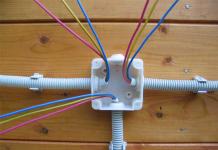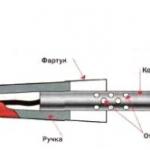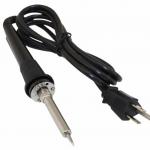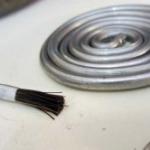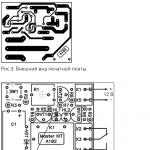With the help of electronic relays, you can save money well, for example, take the light in the corridor, pantry or entrance. By pressing the button, we turn on the light and after a certain time it automatically turns off. This time should be enough to search for an object in the hallway, closet or getting into the apartment. In addition, the lighting unnecessarily does not burn if you forgot to turn it off. This device is not only useful, but also very convenient. In this article, we will tell you how to make a time relay with your own hands, providing all the necessary diagrams and instructions.
The simplest option
An example of a constructor for homemade assembly of a shutdown delay timer:
If desired, it is possible to independently assemble the time relay according to the following scheme:
The timing element is C1, in the standard kit of the kit it has the following characteristics: 1000 uF / 16 V, the delay time in this case is approximately 10 minutes. Time adjustment is carried out by variable R1. Power board 12 volts. The load is controlled through the relay contacts. You can not make a board, but assemble it on a breadboard or by surface mounting.

In order to make a time relay, we need the following parts:

A properly assembled device does not need to be configured and is ready to go. This self-made time delay relay was described in the journal "Radiodelo" 2005.07.
Homemade based on the NE 555 timer
Another do-it-yourself electronic timer circuit is also easy and affordable to repeat. The heart of this circuit is the NE 555 integrated timer chip. This device is designed to both turn off and turn on devices, below is a diagram of the device:

NE555 is a specialized microcircuit used in building all kinds of electronic devices, timers, signal generators, etc. It is quite common, so it can be found in any radio shop. This microcircuit controls the load through an electromechanical relay, which can be used both to turn on and off the payload.
The timer is controlled by two buttons: "start" and "stop". To start the countdown, you must press the "start" button. Disabling and returning the device to its original state is carried out by the "stop" button. The node that sets the time interval is a chain of a variable resistor R1 and an electrolytic capacitor C1. The value of the turn-on delay depends on their rating.

Given the values of the elements R1 and C1, the time range can be from 2 seconds to 3 minutes. An LED connected in parallel with the relay coil is used as an indicator of the state of the design's operability. As in the previous circuit, its operation requires an additional external 12 volt power supply.
In order for the relay to turn on itself immediately when the power is applied to the board, it is necessary to slightly change the circuit: connect pin 4 of the microcircuit to the positive wire, turn off pin 7, and connect pins 2 and 6 together. You can learn more clearly about this scheme from the video, which describes in detail the process of assembling and working with the device:
Relay on one transistor
The easiest option is to use a time relay circuit with just one transistor, KT 973 A, its imported counterpart BD 876. This solution is also based on charging the capacitor to the supply voltage, through a potentiometer (variable resistor). The highlight of the circuit is the forced switching and discharge of the capacitance through the resistor R2 and the return of the initial initial position with the toggle switch S1.

When power is applied to the device, the capacitance C1 begins to charge through the resistor R1 and through R3, thereby opening the transistor VT1. When the capacitance is charged to the VT1 shutdown state, the relay is de-energized, thereby turning off or turning on the load, depending on the purpose of the circuit and the type of relay used.
The elements you have chosen may have a slight variation in denominations, this will not affect the operation of the circuit. The delay may vary slightly and depend on the ambient temperature, as well as on the magnitude of the mains voltage. The photo below shows an example of a finished homemade product:

Now you know how to make a time relay with your own hands. We hope the instructions provided were useful to you and you were able to assemble this homemade product at home!
Today, there are many devices designed to facilitate the life of a modern person. So, time relays also moved from the industrial sphere to the household one, allowing you to automate the work of modern electrical appliances and systems. What types of time relays the modern market offers, how to choose a time regulator and assemble the device with your own hands - read below.
What is a time delay relay
Time delay relays are special devices, the main purpose of which is to ensure the sequential operation of circuit elements for a certain time after the power is turned on or off. The delays created by the relay can be both minute and hourly, as well as daily, weekly in duration. At the same time, with the help of one signal, the relay is able to simultaneously control the operation of several circuits.
According to the principle of operation, time delay relays are divided into devices:
- With electromagnetic deceleration;
- With pneumatic deceleration mechanism;
- With clock or anchor mechanism;
- motor type.
Separately allocate electronic time relays. The time delay in such devices is implemented through analog and digital technical solutions. Often these solutions are represented by digital timers.

Electronic relays are widely used due to the widest range of time delay adjustment.
Thus, an electronic relay is capable of controlling the operation of circuit elements with a time delay from a fraction of a second to several thousand hours. In addition, the advantages of electronic relays include their small size, economical power consumption and versatility. There are also time relays running on microprocessors. Such models are considered the most effective.
Time delay relay classification
For convenience, the time relay is classified according to the type of execution. This classification allows you to divide devices into relays for industrial use and household controllers.
So, all time delay relays are divided into:
- Monoblock;
- Embedded;
- Modular.
The easiest way to install monoblock and modular devices. Monobloc relays are self-contained devices for external installation. Such devices are equipped with built-in batteries, have terminals for connecting the load. Modular relays are a type of monoblock, and are used for installation in electrical panels.

The most common in the industrial and economic sphere are built-in relays.
They are actively used in modern household electrical installations (for example, washing machines), smart home systems. In addition, such devices are used in the automation of greenhouses.
Scope of application of time relay with off-delay
The scope of time relays is extremely wide and depends on the type of device. So, all time relays are divided into devices with a turn-on delay after power is applied and devices with a turn-off time delay after the load is turned off. The most common in the household and utilities are relays with a time delay off.
Most often, devices that create a turn-off delay are used to:
- Automation of street and indoor lighting;
- control over irrigation systems;
- Automation of ventilation systems;
- Control over the operation of household pumps, gas boilers, electric water heaters.
Thus, time relays allow the use of various electrical equipment only according to its actual need, eliminating the possibility of its inappropriate use. This not only saves energy consumption, but also extends the life of electrical appliances.
Relays with a turn-on delay are used to control the operation of industrial and household automation.
So, for example, devices can be used to automatically restore the operation of household appliances, lighting fixtures, ventilation, and heating systems after the resumption of power supply. When properly connected and well configured, delayed turn-on relays can activate the floor heating system when you arrive, turn on water heaters and turn on household appliances (for example, a coffee machine) after you wake up.
The main criterion for choosing a time relay for single-phase networks (220 V) is the delay range. This parameter is determined by the purpose of the trip device. So, for example, for a relay connected to a fan in a bathroom, a turn-off delay in the range from 1 second to 1 hour will be sufficient.
Time relays with turn-on delay usually have a smaller range.
This is related to the scope of their use. Often, after the restoration of power supply, the inclusion of industrial, household and household automation should be carried out immediately. So, the delay for turning on household electrical equipment should be no more than 2 minutes.

In addition, when choosing a time relay, you must consider:
- Switched current type. Relays can switch both alternating and direct current. AC type relay should be selected for AC switching, DC type for DC switching. There are also universal devices labeled AC / DC.
- Maximum switching current. Relays capable of switching loads in the range from 10 to 16 A are suitable for domestic use.
- Degree of protection of the device. For indoor installation, relays with an IP20 index are suitable. For outdoor installation, this figure must be doubled, or the relay must be installed in a protective housing.
- Relay connection options. Separate models of time relays can be simultaneously connected to two elements that control the load (for example, to two switches). So the operation of the relay can be controlled from two points located at different ends of the room.
Do not forget about the overall dimensions and method of mounting the device. This will allow you to quickly fit the device into the project. So, electronic installations have the smallest dimensions. In addition, the timing relay may or may not require mounting a DIN rail.
12 volt relay turn-on delay circuit
You can assemble a simple relay with your own hands. The easiest electronic time relay circuit to implement is assembled on the basis of the ne555 integrated timer. The relay is controlled by pressing external keys. 12V will be enough to operate the device. The relay can be powered through the power cable to the mains. A 12 volt battery can also temporarily support the operation of the relay.
The circuit of a simple time relay based on the NE 555 timer also has the following features:
- The time interval setting node is a circuit of an AC resistor and an electrolytic capacitor. The delay interval for turning on the time relay depends on their rating.
- With a resistor value of 500 kΩ and a capacitor of 220 µF, the delay range can be from 2 seconds to 3 minutes.
- An LED connected in parallel to the coil can act as an indicator of the relay's operability.
This device can be used both to turn off and turn on electrical equipment with a time delay. To start the time countdown, you must press the “start” button, which starts the timer. The “stop” button is responsible for turning off the power and returning the device controlled by the relay to its original state.
Content:
Both in everyday life and in production, there is a need to turn off electricity consumers after a given period of time. To break the electrical circuit, you need either a contact or a controlled semiconductor device. And to form a given period of time, you will need either a stopwatch or a timer. It all depends on the direction in which the time is counted.
The stopwatch adds seconds and the timer subtracts. The only difference is this. But the time interval, if given, is the same for both. And a contact or a semiconductor device for switching is part of a relay - electromechanical or semiconductor. If we combine the relay with a timer or stopwatch, we get a time relay (RT). Further about this device in more detail.
Appointment of RV
There are many types of RV. You can use the same timer or stopwatch for a large number of switches of different capacities. And vice versa. The same switching system can be combined with a wide range of timer and stopwatch models. Both can be seen on the market today. Many time relay models are very similar not only externally, but also according to the technical description.
If the reader is interested in visually familiarizing himself with the work of RV, there is no need to go far. All washing machines produced since the 60s of the twentieth century are equipped with a time relay with a mechanical timer. By turning a special switch in these machines, a certain interval was set, and a mechanism, similar to a clock, began to tick, counting the seconds. And the rotary switch, like a clock hand, moved back to its original position.
In modern household appliances that are used for cooking, the time relay is also a central element of automation. This is immediately noticeable on the scoreboard or rotary switch, as in a washing machine. In general, there are several options for the fundamental construction of a time relay. All of them use certain principles of formation of the time interval known to science. Let's consider some of them.
Basic Options
- Electronic digital. The RV of this system is the most modern and accurate. They run a generator, the frequency of which is stabilized by a special device. The most widely used for this crystal is quartz. Most likely, the reader has already met the name "quartz oscillator". It outputs voltage at a constant frequency and is insensitive to changes in ambient temperature. The signal generated by the generator is used to generate stable pulses. They are counted by special microcircuits. Based on this, a signal is generated that controls the switch RT. In this way, you can most accurately form a time interval of any duration.
- Electronic analog. Based on the so-called time constant of the RC circuit. It is determined by the fact that it takes more time to fully charge (discharge) the capacitor through the resistor, the greater the resistance of the resistor. On this principle, it is possible to create sufficiently accurate and simple in design RV. Their time intervals will be within units of seconds.
- Electromagnetic, or induction. These are two definitions of the same principle of operation. It is based on the fact that an electromagnetic field cannot appear and disappear instantly. Depending on the value of the inductance of the element and the special design of the cores, a transient process is obtained with a duration from hundredths to several seconds. A time-tested system still used today in special RVs.

- Pneumatic mechanism. It has long been used in industrial equipment. It well solves the problem of synchronous operation of a large number of actuators. The system is easily and visually adjusted by changing the diameter of the opening for air movement. The larger its dimensions, the faster the air flow will fill the working volume (for example, a cylinder with a piston) of this pneumatic mechanism and, accordingly, the shorter the response time interval of such a RV. And vice versa. The time interval for such relays is within minutes.

- Clockwork. It is also called anchor. This is the most common of all options for the shapers of the time interval. It is based on the deformation of the spring. It is strained when the mechanism is started, and the elastic force of the return to its original state, slowed down by gears and flywheels, provides one or another time interval. Ultimately, the force of the spring moves the actuating contact, which either directly breaks the electrical circuit or controls the relay. By the operation of the washing machine, you can judge what time can be set for such a RV.

- Electromechanical design. Works on the basis of a multi-pole synchronous motor. The speed of rotation of this motor depends only on the frequency of the supply voltage. If it is provided by a 220 V industrial network, the frequency is very stable. The key to this stability is the mass of generator rotors in power plants. You can create a time interval of several hours. They have industrial application mainly in relay protection circuits. You can set any time interval in the absence of power failures.

A couple of schemes for craftsmen
If you need to make a time relay with a 220 V turn-off delay with your own hands, it is best to stop at a technical solution using an electromechanical relay. This classic relay provides galvanic isolation of the contacts. And it will be more difficult to spoil it during, so to speak, development work in comparison with other models. With galvanic isolation of contacts, there are other constructive types of relays - reed switches and optoelectronic devices.

But in order to reliably disconnect load currents at a mains voltage of 220 V, it is better not to use a relay. If only because the mechanical contacts spark and wear out for this reason. Therefore, as the voltage and current strength that must be turned off increase, the dimensions of the contacts and the relays themselves increase significantly. A symmetrical thyristor will do this task much better. And it is more expedient to use an electromechanical relay, a reed switch or an optoelectronic semiconductor assembly to control a triac.
The time relay will most likely be used to control lighting. This is a short period of time. Therefore, it does not make sense to use a complex scheme for its formation. To control any lamp used for lighting at home, the widely used triac KU208G is quite sufficient. The design idea of such a time relay with a 220 V turn-off delay is to replace the light switch with it.
This can be useful, for example, in order to turn on the lighting in the corridor before entering the entrance or apartment, get the keys and open the front door. And do not think after that that the light must be turned off. If you use the outdoor switch of a private house or the entrance of an apartment building, it may not be safe in wet weather. Yes, and the younger generation can fool around, constantly turning on the light for fun. Or leaving the garage and closing it at night, it is better to go out into the illuminated space in front of it, and not into the darkness. The situation is the same with the external switch.
The idea of the circuit is based on creating a capacitor charging current, which simultaneously controls the triac. While the capacitor is charging, the triac is open and current flows through the load (lamp). After the strength of the charging current decreases and goes beyond the threshold of holding the on state of the triac, this semiconductor switch will break the circuit with the load, and the lamp will go out. The circuit is turned on by a button that discharges the capacitor and simultaneously turns on the triac.

The value of R1 should not be less than 500 ohms
This circuit uses two identical 127V lamps and two identical 250mA rectifier diodes. Lamp power can be selected from 25 to 500 watts. Two lamps create conditions for the control current of the same sign to be the same for each half-cycle. In this case, the triac will work symmetrically on the positive and negative half-waves. But you can use one 220 V lamp in this circuit.

The value of R1 should not be less than 2 kOhm
However, with it, the triac will not equally pass both half-waves of current, and the lamp will not give out the rated luminous flux. For the full operation of one lamp, a different circuit is needed (see below). For S1, we recommend using the button from the input call. C1 and R1, as their ratings increase, prolong the glow of the lamps.
Schemes of devices with a given time delay.
On fig. 1,a is shown circuit diagram of time relay with off-delay loads in the form of incandescent lighting lamps. Similar relays can be installed in corridors, stairwells, hallways in order to save electrical energy and increase lamp life.
When the button S1 is pressed, the capacitor C1 is discharged through the resistor R5 and the diode V5. In each positive half-cycle of the mains voltage, the capacitor is charged through the emitter junction of the transistor V3, as a result, the trinistor VI opens and turns on the HI lamp. During the negative half-cycle of the voltage, no current flows through the device. After the button is released, in each positive half-cycle of the voltage, the current through the diodes V2, V4, the resistor R4 and the emitter junction of the transistor V3 recharges the capacitor C1 and the lamp glow gradually decreases. Needed lamp turn off time set with a trimmer resistor R3. The maximum time delay of the relay on turning off the lamp is about 10 minutes. At the end of the exposure, the incandescence of the lamp begins to decrease. In standby mode, the device does not consume current from the network. In the time relay, you can use any diodes from the KD105 series or D226B diodes. The transistor is required with a maximum allowable collector-emitter voltage of 300 V. It is advisable to choose capacitor C1 in a sealed version, for example, an EHC. The VI trinistor must be rated for a reverse voltage of at least 300 V.
On fig. 1b shows the second option. timing relay circuits with a delay of  load shedding. The maximum time delay is about 20 minutes, and the current consumed in standby mode is 2 mA. When you press the S1 button, the negative half-cycles of the network charge the capacitor C1 to the stabilization voltage of the zener diode V5. When transistor V4 closes, and V3 and trinistor VI open, the HI lamp turns on. After releasing the button, the capacitor is discharged through the tuning resistor R5, which sets the desired time delay. Any diodes for a reverse voltage of at least 400 V are suitable for the device; transistor for the maximum allowable voltage collector - emitter 300 V. Instead of KP302A, you can use transistors KP302B, KP305D, KP305E.
load shedding. The maximum time delay is about 20 minutes, and the current consumed in standby mode is 2 mA. When you press the S1 button, the negative half-cycles of the network charge the capacitor C1 to the stabilization voltage of the zener diode V5. When transistor V4 closes, and V3 and trinistor VI open, the HI lamp turns on. After releasing the button, the capacitor is discharged through the tuning resistor R5, which sets the desired time delay. Any diodes for a reverse voltage of at least 400 V are suitable for the device; transistor for the maximum allowable voltage collector - emitter 300 V. Instead of KP302A, you can use transistors KP302B, KP305D, KP305E.
On fig. 1,c shows a diagram of another option time relay for  automatic switching off of lighting lamps. The maximum time delay of the relay is about 20 minutes, the current consumption in standby mode is 2 mA. When you press the S1 button, a current flows through the resistor R1 and the diode V7, charging the capacitor C2 to the stabilization voltage of the zener diode V5. At the output of element D1.1, a low-level voltage is set, at the output of D1.2-high (logical 1 signal). Transistor V4 and trinistor V2 open and the HI lamp turns on. After the button is released, the capacitor C2 is discharged through the tuning resistor R6, which serves to set the desired shutter speed. After the capacitor C2 is discharged to a voltage of approximately 4 V, the transistor V4 and the trinistor V2 close and the lamp goes out. The requirements for the diodes and transistor of the device are the same as in the previous relays. Instead of the K176LA7 chip, you can use the KI76LE5. The trinistor must be designed for a reverse voltage of at least 300 V. If the total power of the lamps connected to the time relay exceeds 600 W, the trinistor must be installed on a heat sink. With proper installation and serviceable elements, the described time relays begin to work immediately, without adjustment. Since a voltage of about 155 V is applied to the switched on lamp, ordinary 220 V lamps in the time relay will burn with an incomplete glow.
automatic switching off of lighting lamps. The maximum time delay of the relay is about 20 minutes, the current consumption in standby mode is 2 mA. When you press the S1 button, a current flows through the resistor R1 and the diode V7, charging the capacitor C2 to the stabilization voltage of the zener diode V5. At the output of element D1.1, a low-level voltage is set, at the output of D1.2-high (logical 1 signal). Transistor V4 and trinistor V2 open and the HI lamp turns on. After the button is released, the capacitor C2 is discharged through the tuning resistor R6, which serves to set the desired shutter speed. After the capacitor C2 is discharged to a voltage of approximately 4 V, the transistor V4 and the trinistor V2 close and the lamp goes out. The requirements for the diodes and transistor of the device are the same as in the previous relays. Instead of the K176LA7 chip, you can use the KI76LE5. The trinistor must be designed for a reverse voltage of at least 300 V. If the total power of the lamps connected to the time relay exceeds 600 W, the trinistor must be installed on a heat sink. With proper installation and serviceable elements, the described time relays begin to work immediately, without adjustment. Since a voltage of about 155 V is applied to the switched on lamp, ordinary 220 V lamps in the time relay will burn with an incomplete glow.
A time relay with a power of not more than 100 W with a delay for turning off the lighting lamp of about 10 minutes can be assembled according to the circuit diagram shown in fig. 2.  The device is started by briefly turning on the switch S2 (with S1 on). The required shutter speed is set with a variable resistor R4. The time relay can be assembled on any low-power silicon transistors of the appropriate structure with a static current transfer coefficient of at least 50, for example, KT312B. Diodes VI - V4 must withstand a forward current of at least 300 mA and a reverse voltage of 400 V (for example, D226B); diode V5 - any low-power silicon. The trinistor should be selected with a permissible forward voltage of at least 300 V. If the trinistor has too much control current, it is necessary to connect a resistor of the same resistance in parallel with the resistor R2.
The device is started by briefly turning on the switch S2 (with S1 on). The required shutter speed is set with a variable resistor R4. The time relay can be assembled on any low-power silicon transistors of the appropriate structure with a static current transfer coefficient of at least 50, for example, KT312B. Diodes VI - V4 must withstand a forward current of at least 300 mA and a reverse voltage of 400 V (for example, D226B); diode V5 - any low-power silicon. The trinistor should be selected with a permissible forward voltage of at least 300 V. If the trinistor has too much control current, it is necessary to connect a resistor of the same resistance in parallel with the resistor R2.
Time relay, circuit diagram which is shown in Fig. 3,  allows you to smoothly increase the current through the lamp to the nominal value for I s after it is turned on. This allows you to significantly increase the life of the lamp. The lamp power is not more than 100 W, with a higher power, the KD105B diodes should be replaced with KD202Zh, KD202S. KT315B transistors can be replaced by any low-power silicon of the appropriate structure with a static current transfer coefficient of at least 50. The V8 diode is low-power silicon.
allows you to smoothly increase the current through the lamp to the nominal value for I s after it is turned on. This allows you to significantly increase the life of the lamp. The lamp power is not more than 100 W, with a higher power, the KD105B diodes should be replaced with KD202Zh, KD202S. KT315B transistors can be replaced by any low-power silicon of the appropriate structure with a static current transfer coefficient of at least 50. The V8 diode is low-power silicon.
Schematic diagram of a time relay for switching lighting and heating devices with a power of not more than 100 W with an adjustable shutter speed from 5 s to 30 min is shown in fig. 4.  Transistor V6 must be designed for the maximum allowable collector-emitter voltage of 300 V. You can try replacing it with a KT605B transistor. The KP302A transistor can be replaced with KP302B or KP302V, but the time delay will be shorter due to the higher cutoff voltage for these transistors. Capacitor C1 should be selected with a low leakage current, for example K52-2, K52-1, IT. To work with a time delay of up to fractions of a second, instead of the tuning resistor R4, you need to turn on the multi-position switch with a set of fixed resistors.
Transistor V6 must be designed for the maximum allowable collector-emitter voltage of 300 V. You can try replacing it with a KT605B transistor. The KP302A transistor can be replaced with KP302B or KP302V, but the time delay will be shorter due to the higher cutoff voltage for these transistors. Capacitor C1 should be selected with a low leakage current, for example K52-2, K52-1, IT. To work with a time delay of up to fractions of a second, instead of the tuning resistor R4, you need to turn on the multi-position switch with a set of fixed resistors.
12 schemes for the use of relays in everyday life. 2 nuances - with a delay on or off. 4 knowledge test questions. 3 best relays for ordering on aliexpress.
What is a time relay (hereinafter R.V.) with a delay
Normal relay is designed to turn on devices after receiving a signal. Time relay does not work immediately, but after the passage of a period of time specified during its manufacture or configuration. If executed with a delay, then another period is counted before switching on or off. It is also either provided in the manufacture of the device or configured (programmed).
TEST:
4 questions to test the theory- Is it possible to use a delayed relay like a regular relay?
a) No, they are completely different devices.
b) Yes, for this we set the delay to zero. (loyal)
- Are relays with on-delay and off-delay different?
a) Yes, the former work out the delay before starting the main timer, the latter only maintain the time after the shutdown command. (loyal)
- Is it possible to replace a relay with an off-delay with a relay with an on-delay?
a) No, they are different devices. (loyal)
- Can a time delay relay be replaced by two conventional time relays?
a) Yes, if they are connected correctly. (loyal).
Important to know - relay with on and off delay 2 different devices
Normal time relay turns on the device mounted after them for a period of time set during configuration. Latency devices don't work that way.
OFF-delay - 1 Reverse Operated Relay
- The relay is signaled to turn off the device.
- The countdown of the delay time begins, after the period has expired the device turns off.
If such relay mounted in front of a conventional lamp, it will not go out immediately after the switch has tripped, but after the delay time has passed.
On-delay - 2 devices in one
- On relay a signal is given, it turns on its mechanism or electronic circuit.
- The delay time is immediately counted.
- After the time has been counted, the relay turns on the connected device for the specified time.
In fact, these are two relay time connected in series.
12 ways to use a relay at home
RV connection diagram for 2 switches with a delay off 220v
OFF-delay relay it is possible to apply in order not to forget to turn off the light in the pantry or on the landing. To do this, we connect the lamp through it.

In order for the circuit to work correctly, non-latching switches must be used instead of conventional switches. Regular buttons will work too.
The scheme works as follows.
- Entering the room, you close the switch, turning on the lighting.
- The switch is not fixed in the closed position, then, releasing the switch key, you immediately interrupt the power supply.
- The lighting does not turn off, the lamps are connected via OFF-delay relay.
- The lighting will turn off only after the set time has elapsed.
- For protection, an automatic switch is installed in front of the relay, it will de-energize the device if the current rises above the set value during a short circuit (according to PUE paragraph 7 3.1.14-19).
This scheme is convenient for long corridors. Lighting can be switched on from both sides of the room. If this possibility is not needed, then the switch can be left alone.
Option 2 - delay circuit for turning on an incandescent lamp 220v on a self-assembled relay
This scheme is suitable for those , who likes to make and is familiar with radio electronics. In it, instead of a ready-made device, designed to be powered by networks 220 volts, we use a 12 relay as it's safer. We make relay from standard electromagnetic with one contact group. Scheme alterations and appearance of the device are shown in the figure below.
The above scheme is not designed to work with a powerful load due to the limited capabilities of the contact group. If such a need arises, then an intermediate relay must be introduced. No brand difference, domestic applicable RPL, RPU-2M, RP, REP or imported (today there are more of them on the market and their price is lower, the three best relays with aliexpress we present below).

Look at the picture: a standard intermediate relay. To fit it into our circuit, we connect the contacts "N" and "A" not to the points "L" and "N", but to the points "30" and "87" in the previous diagram.
RV with turn-on delay 220v 2 more circuits for lighting control
Option 2 of the lighting control device is assembled on multifunctional digital relays.

At digital relays much more possibilities. The delay can be set not for 10 15 minutes, but for a duration of more than a day. It is possible to set the time when the light will turn on. Option 1 is suitable for controlling street lighting in a personal plot. We configure the relay to turn on at 17 o'clock and work out the delay, 13 o'clock. Street lamps will burn all night, and go out at dawn.
The device is also connected to work with two managed networks, as in the second diagram. The two channels are configured completely independently.
RV 220v on an element from Schneider or another, energy savings up to 10% for an air conditioner,
Often the air conditioner is turned on with the window open, so they run idly and waste electricity. The way out of the situation is to install the sensor on the frame sash and connect it to the power line. But this approach is also not very correct.
If you open the window for a short period of time (let the cat in), the air conditioner will turn off and then turn on again. The current consumption in the start-stop mode increases, such work also does not increase the durability of the device.
We avoid problems by installing the "sensor-switch of the air conditioner" in the circuit OFF-delay relay. The diagram is shown below.

The circuit does not even provide for a special relay with a delay; its functions are performed by an ordinary intermediate relay. It works as follows.
- When the window is opened, the contacts are closed, voltage is applied to the relay.
- The current required for operation is not immediately supplied to the corresponding terminals, but is spent to charge the capacitors. For decoupling in scheme diodes are on.
- After the capacitors are charged, the current rises to the value necessary for the relay to operate. The relay turns off the air conditioner.
- If the window is already closed, then after the capacitors are discharged (due to the minimum current flow in the opposite direction through the diode), the relay again supplies voltage to the air conditioner.
R. turn-on delay 220v 2 repair option for the refrigerator.
If it is difficult to find a regular temperature sensor, the option is to install any suitable one. And in order for the compressor not to turn on and off, we mount the same circuit as for the air conditioner.
Modernization of the control of 4 power windows
Normally, the windows in the car do not work when the ignition is off. A case is possible - having stopped for a few seconds, we cannot open the window to pay the refueling operator. To eliminate the situation, we modernize the electrical equipment control circuit by setting switch-off delay relay.
Option homemade time relay with a delay of 24 volts
The previous circuit provided power from a 12 volt unit. We offer another option, powered by 24 V. It is suitable for trucks, in their network such voltage.

The device is assembled on domestic elements, canopy installation. With the help of a variable resistor (it is at the very bottom of the circuit), the turn-off delay time is adjusted.
3rd power window control scheme on imported parts
If there are problems with the acquisition of domestic radio elements, we assemble relays with a delay on imported ones. Parts are soldered from the boards of a failed computer. Below is a diagram.

The device works in the same way. By changing the capacitance of the capacitor C1 or resistor R2, we adjust the delay time.
DIY time relay
R. turn off delay 220v fan for 1 hour with your own hands
Another use case delayed relay- fan or extractor control in the shower or lavatory. Here is a diagram for assembling it yourself.

It works in two modes selectable with a switch on the relay. The signal for the relay to operate is the supply of voltage to the lighting of the room.
For shower:
- Lights are turned on in the room.
- You are using the bathroom.
- When you left, you turned off the light.
- The delay time starts (until steam accumulates).
- After a delay, the fan turns on for the time necessary to remove the steam.
For restroom:
- After the light is on, the countdown begins.
- After half a minute or more (depending on the settings), the hood will turn on.
- The fan runs for the programmed time.
R. temp. with delayed switch-off options 2 and 3, 220V for exhaust
The proposed scheme can be assembled on imported relays, two options are shown below.

The algorithm of these schemes is as follows.
- Simultaneously with the inclusion of lighting, the hood is turned on.
- After the lighting is turned off, the countdown begins.
- When the delay has passed, the fan is de-energized.
Devices are configured for the operating time after turning off the light is 15 minutes. To change the delay, it is enough to turn the knob on their panel with a Phillips screwdriver or any similar tool.
Scheme for extracting RV with a delay off 220v on a domestic component or option 2 on a device from abb
Instead of with special relays for fan, use multi-functional. The figure below shows domestic models, but it is easy to find and select imported ones.

The option is to choose ABB products.

Devices are connected to the fan power circuit, and then the knobs adjust the operating time and delays.
Domestic relays are two-channel, the second channel can be used to control lighting. To do this, you need to set them so that the light goes out after a time sufficient to use the room. Energy savings are achieved if there are forgetful people in the house.
Homemade R. for delaying the activation of a car alarm
Another option for using the delay is to include it in the car alarm circuit. Variants of this security system block the doors immediately after you close them, this is not very convenient, slamming the car with the keys and the alarm control key fob remains on the street. If you mount the relay with a delay of one or two minutes, the driver will have time to correct the error. Here is a variant of the diagram.

The device is assembled on domestic radioelements by a canopy and is included in the power supply circuit of the security system. By changing the capacitance of the capacitor, you can adjust the delay time.
RV with turn-off delay 220v from 3 best devices from aliexpress
Buying a relay on the aliexpress portal saves money. We list the top three devices on this service.
First, second and third number in our relay rating
Answers to frequently asked questions
At the end of the article, we will answer some of the most frequently asked questions.
Question. Which option is preferable for a 12 V relay and an intermediate one for 220 or immediately designed for high voltage?
Answer. First option more secure when setting up, the second is easier to install.
Question. Which relay is preferable mechanical or electronic?
Answer. Mechanical cheaper, electronic reliability and functionality they are surpassed.
Question. Are imported devices more reliable?
Answer. Russian standards are tougher than foreign ones, so it is preferable to choose domestic devices.
3 common mistakes when choosing R.V.
- Select a relay whose maximum or minimum adjustable operating period is close to the required operating period. It is necessary that the time that the device will most often work out is in the middle third.
- The relay is not designed for the connected load. Before choosing, determine the maximum current of the controlled relay devices and study its characteristics.
- The device intended for premises is mounted in the open air. The relay for outdoor installation must have a protection class of at least IP 68.
We hope this article was not only informative, but also practically useful. It’s great if she helped make the home more comfortable and cozy.


